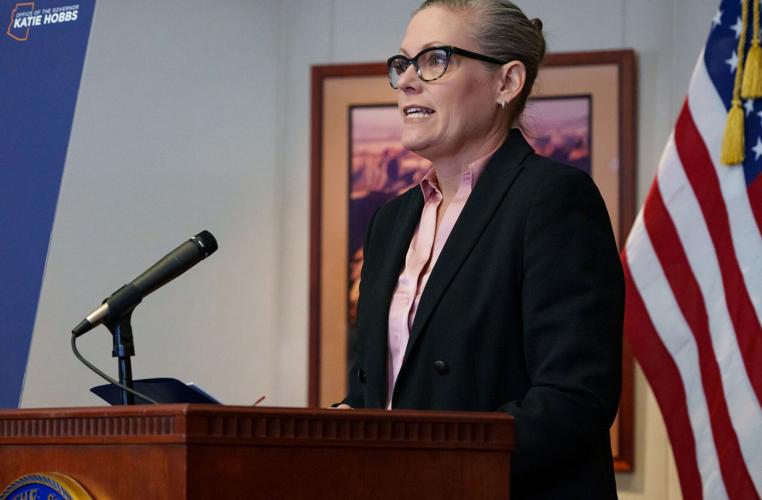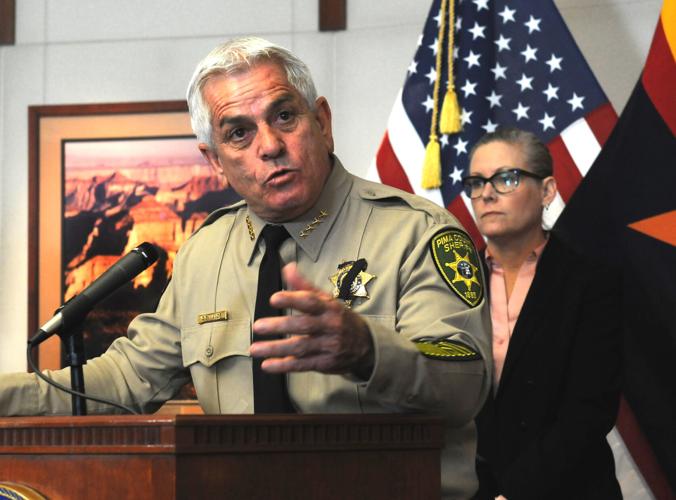PHOENIX — Gov. Katie Hobbs’ five-point plan to deal with what happens Friday, when the Border Patrol loses its authority to immediately deport people who enter the United States to seek asylum, includes lots of ideas but is short on specifics.
And much of what she says she may do already takes place.
The Democratic governor said Monday she will keep using state resources to ship migrants who have been released from Border Patrol custody to other parts of the state and country.
She also promised executive actions, though with no details.
“The situation is fluid,’’ Hobbs said. “We’re going to continue to monitor.’’
One option, she said, is sending National Guard troops to the border.
Arizona already does that, with the 180 soldiers there handling routine, non-law-enforcement duties to help free up Border Patrol agents. Hobbs said there could be more but that she couldn’t say how many and what they would do.
Asked how much money will be spent on emergency shelters for migrants, Hobbs said, “We don’t know the numbers because we don’t know the number.”
“We don’t know what the need is actually going to be,’’ she said at a press briefing she held Monday with other officials. “We’re dealing a lot with speculation.’’
Surge seen in Yuma
When authority to deport migrants under the Title 42 public-health policy used during the pandemic ends at midnight Thursday, U.S. border agents will lose the authority to simply send asylum-seekers back to Mexico.
Yuma Mayor Douglas Nicholls said a surge is already beginning.
“About a month ago, we had 300 people a day crossing the border in the Yuma sector,’’ he said.
Two weeks later, the daily figure hit 600. Sunday, it reached 1,000.
“And this morning, at 8 o’clock, there was already 500 people that have crossed into the Yuma sector,’’ Nicholls, a Republican, said at the press briefing. “This is not stopping anytime soon.’’
Shelter funding needed
Hobbs said she is counting on “a very large pot of (federal) money’’ to deal with the fact there are going to be hundreds, if not thousands, of migrants released into this country, all of whom will need shelter. But what is missing — and what Hobbs said she needs — is a guarantee those funds will be focused on border communities.
“Right now, we’re in competition with all of the states for that funding,’’ she said.
Still, Hobbs said there are contingency plans to deal with the immediate problem.
She said the new state budget she and Republican legislative leaders are finalizing will include increased funding to deal with homelessness. But she’s not happy with the idea of some of that money being funneled off to deal with the end of Title 42.
“I will tell you, the intent isn’t necessarily to be used on the shelter,’’ Hobbs said. “We shouldn’t have Arizonans paying for something that’s a federal responsibility.’’
Local law enforcement role
The governor’s preparedness list also includes having the state Department of Public Safety assist local sheriffs and law enforcement with public safety and drug interdiction.
DPS Director Jeffrey Glover insisted he will not divert officers from highway safety. Instead, he said, sworn officers with responsibilities other than road safety can be called in to help.
The transportation aspect of Hobbs’ plan is a continuation of a program started by Republican Gov. Doug Ducey, her immediate predecessor.
Ducey was sending busloads of migrants to D.C. with no arrangements for them when they got there, and whether or not Washington was where they wanted to go.
Hobbs, on taking office in January, started adding flights with an eye on putting the migrants closer to families and organizations that can provide support.
But the bottom line, she said, is the state just can’t handle the problem on its own.
Lashed out at Washington
If there was a common theme to Monday’s briefing it was that everyone there was blaming Washington, D.C.
“Without much more robust action from the federal government, the current situation will only get worse,’’ Hobbs said. “I’m afraid the federal government is unprepared to meet the demands of the expected influx.’’
Hobbs also released copies of letters she sent over a week ago to President Joe Biden and Homeland Security Secretary Alejandro Mayorkas, asking what they intend to do.
“As of today, we have not received an adequate response,’’ she said.
“This is a federal government problem,’’ agreed Pima County Sheriff Chris Nanos, a Democrat.
“And for the state to have to take it on, for each county to have to take it on without funding, without any resources, without any housing or food or health care for these migrants, that’s just not right,” Nanos said.
Watch now: Pima County is preparing to receive an increased number of asylum seekers when Title 42 ends on May 11. Video courtesy of Pima County





